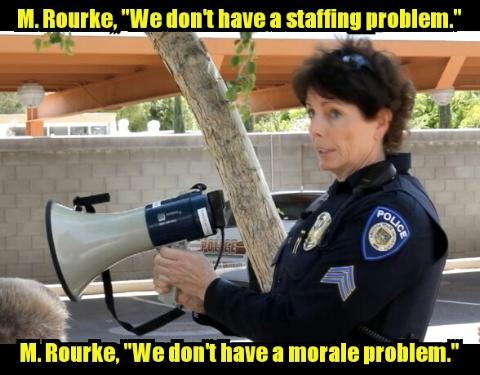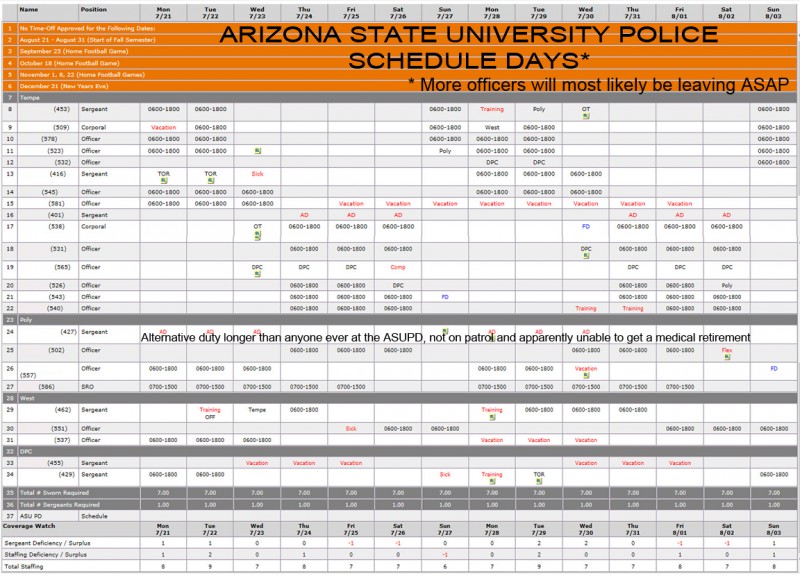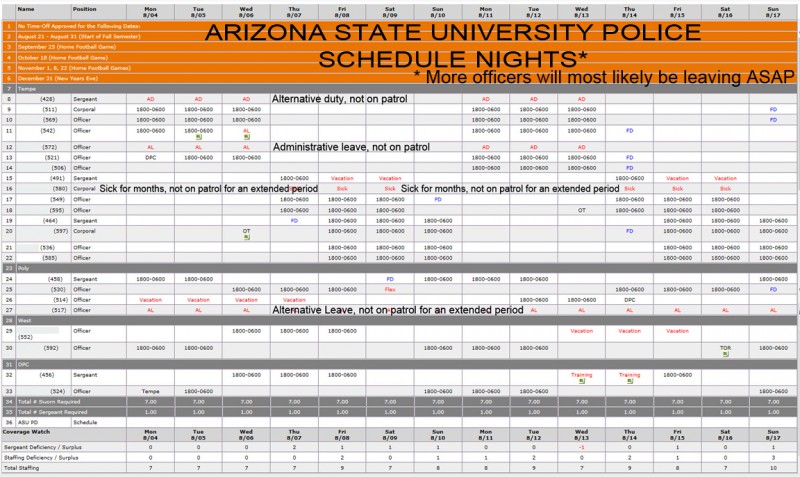Anne Ryman and Rob O’Dell, investigative reporters from the Arizona Republic, have been digging into our assertions that Arizona State University’s Police Department is understaffed, due in part to low departmental morale (which negatively effects employee retention).
From azcentral.com:
Arizona State University’s Police Department struggled to schedule a full complement of patrol officers, failing to meet its own requirements a majority of the days during the spring semester, The Arizona Republic found.
Six out of seven days during the semester, at least one shift did not have all seven officers scheduled, as ASU police requires to patrol Tempe and three other satellite campuses.
As a result, supervisors had to either pay overtime, reassign someone from another job or leave positions on a shift vacant. The department can’t say how often it left a post empty on any given patrol shift.
MORE: ASU police acquire M-16 assault rifles
Public records, the police chief’s advisory-board documents and interviews with more than a dozen current and former employees paint a picture of an agency that is understaffed for patrol shifts.
It’s not clear whether the staffing shortage affects crime rates. But records and interviews show the department sometimes needs to pull officers from performing other duties, such as criminal investigations and proactive police work like crime prevention, to work patrol shifts.
Former officers have expressed concern about their safety and the safety of students in a report to the police chief and questioned whether the department had the staffing and training to properly respond to a shooter on campus.
That report has a section on morale, where past employees who were interviewed contend the department is “short staffed by 50-80 officers. This is a stressor for the officers that still work there.”
Campus police staffing levels have not kept up with ASU’s enrollment. ASU’s ratio of sworn officers to students is about25 percent below the national average for large, public schools, a national report found.
ASU officials acknowledge there have been staffing challenges but have been hiring to bolster department resources. The police budget was increased for the budget year that began July 1 with a half-dozen new officers hired since then. ASU police officials recently signaled how important it is to have a more visible police presence when they announced they were beefing up patrols following a sexual assault on campus Sept. 9.
Morgan Olsen, ASU’s executive vice president and chief financial officer, said the university places a priority on having safe and secure campuses, and to his knowledge, public safety hasn’t suffered with the staffing.
Some police agencies reduced staffing during the recession, but ASU didn’t eliminate police officers or aides, he said, even as the university’s state funding was cut 40 percent and ASU eliminated 2,055 jobs in other areas.
“Generally, we’ve been able to maintain coverage and maintain responsiveness,” Olsen said.
ASU President Michael Crow, who has often touted the safety of the campuses, said through a spokesman that Olsen was the appropriate ASU official to speak about police staffing.
In June, Police Chief John Pickens, who had led the department for 14 years, announced that he was transferring to a newly created job in charge of university security initiatives.
An ASU student-safety task force is recommending the Arizona Board of Regents, which oversees the state universities, conduct an independent review of the safety needs at all three state universities. The task force was formed in response to a series of articles in The Republic last September about alcohol-related crimes.
The regents will hear safety recommendations at a meeting this week in Flagstaff.
But one former employee is clear what he believes the university should do: increase staffing.
Retired ASU Sgt. Marvin Tahmahkera compared the daily scheduling of patrol officers to a popular video game in which a player must manipulate random blocks into position before the pieces fall to the bottom.
“Every day it seemed like a game of Tetris. Someone would call in sick,” said Tahmahkera, who retired last year after 22 years with the department.
He recalls responding to a domestic-violence call by himself at ASU’s Polytechnic campus, a situation where law-enforcement best practices say having a backup officer is a necessary precaution. The staffing levels sometimes made it difficult to patrol dorms, look for underage drinkers and rattle doors at night to make sure they were locked.
“Many times I was the officer in charge, and I was just praying nothing would happen that night,” he said.
Short staffing
ASU is the largest public university in the country with 82,000 students, including 13,000 online-only students. The Tempe campus alone covers more than 700 acres with 57,800 students.
A typical patrol shift has seven sworn officers, including a sergeant, to watch over ASU’s four Valley campuses: Tempe, West, Polytechnic and downtown Phoenix.
But on six of every seven days in the spring semester, ASU was unable to schedule the full seven staff officers for at least one of the three daily patrol shifts. The shortage could have been caused by a variety of factors, including officers out sick, on vacation, injured, on family-medical leave or at court.
On more than half of the 151 days examined by The Republic, at least two of the three daily patrol shifts were scheduled to be short staffed. All three shifts were consistently scheduled to be short of staff, The Republic found, with the swing shift beginning in late afternoon the most underscheduled.
ASU police and administrators contend that not every shift had vacancies because they used overtime pay or pulled someone from another job to cover the open position. The university could not say which shifts they were able to cover, saying it would take them weeks to determine if officers actually worked those shifts.
Staffing levels sometimes dipped so low the Tempe campus would have only two officers on staff, according to a report given last year to the police chief based on interviews with police officers and aides.
The university can call surrounding city police agencies for backup when help is needed. But officers from another agency are sometimes unfamiliar with the campuses, so it takes them longer to arrive.
Olsen acknowledged that last fall, an unusually high number of people were on family-medical leave for injuries or as new parents, he said. Others had to work more overtime as a result.
“We’ve pretty well worked our way out of that now,” he said. “But we’re continuing to build because we would like to have a force that allows us to do just a little more now than we have been doing.”
The department had 74 full-time officers at the end of the fiscal year. Department officials say they’ve hired six since July and say they plan to hire nine more, which would bring the total to 89 sworn officers and supervisors.
Below U.S. averages
ASU has about 1.1 sworn officers for every 1,000 students, below the national ratio of 1.5 for large, public schools, and below the University of Arizona’s 1.6.
A 2005 survey by the U.S. Department of Justice found larger public schools with more than 15,000 students had 1.5 sworn officers per 1,000 students.
Filling all the budgeted slots would bring ASU up to 1.3.
ASU’s five-member investigative unit has one less person than UA’s, which has 40,000 fewer students and fewer violent crimes.
When 42 police aides are factored in, ASU officials said, the per-student ratio of police to students is higher. The aides help patrol, respond to emergency calls such as minor traffic accidents and take reports on minor thefts. The mostly full-time aides are not required to go through the police academy, they don’t make arrests and they don’t carry guns.
The department plans to hire 20 more police aides this year.
But David Perry, president of the International Association of Campus Law Enforcement Administrators, said it’s not appropriate to include police aides in the per-student ratios because aides cannot perform all the functions of a sworn officer.
Campus law-enforcement experts say there is no universally accepted method of determining staffing and no “magic” number of officers per student, though enrollment is a key factor. More students means more calls for service, Perry said.
Campus police in some other areas of the country also are grappling with determining the appropriate number of staff.
Last year, Capt. Eric Chin of the Purdue University Police Department surveyed schools in the Big Ten Conference. He found the highest ratio at the private Northwestern University at 2.9 per 1,000 students. Ohio State was the lowest with 0.85 officers per 1,000.
Olsen said ASU uses a more complex calculation than enrollment to determine staffing, including crime trends and the department’s ability to cover the campuses. He said he wouldn’t necessarily characterize the department as being understaffed.
“If you were to go out and ask a particular department in the university, maybe the biology department or the folks who maintain the grounds, ‘Are you understaffed? Could you do more with more people?’ Well, sure, we could do more good things with more people. So that’s not necessarily surprising,” he said.
‘Malls’ for thieves
Whether the staffing shortages affect crime rates is inconclusive.
Crime statistics reported to the federal government under the Clery Act show a mixed picture of ASU’s Tempe campus. The Republic compared ASU with its 15 peer universities along with University of Arizona and Northern Arizona University from 2008 to 2012, the latest data available.
Rates of forcible sexual offenses and robbery have risen at ASU’s Tempe campus, while burglary and aggravated assault rates have fallen or remained the same. ASU’s rates of sexual offenses are lower than most of its peer schools. It has a higher rate of robbery and a much higher rate of aggravated assaults when compared with its peers.
The Republic filed public-records requests July 29 with ASU for police response times and clearance rates for crimes, but the department has not provided the information.
Tahmahkera, the ASU retired sergeant, calls ASU a “big shopping mall for thieves” because of the open nature. A student gets up to get a drink of water and leaves his laptop on a table. He returns to find it gone, including his paper due for class.
The Tempe campus reported 963 thefts and another 98 burglaries, the category that includes bike thefts, in 2012, the most recent year annual statistics are reported to the federal government.
Violent crimes are rare. The Tempe campus reported 16 sexual offenses in 2012. Ten robberies and 10 aggravated assaults occurred on campus that same year.
A larger police force is something the university has planned for several years, ASU’s Olsen said. But like a lot of other things, it didn’t get funded during the recession.
The university would like to have more officers at the downtown Phoenix campus as well as multiple officers on the West and Polytechnic campuses, he said.
Staff discord
Blogs and public comments show conflict within the campus police department.
An anonymous blog called “The Integrity Report” published complaints about working conditions and a supposed clique that runs the department. Then, the video of an ASU officer arresting an African-American professor in May went viral. Civil-rights groups were outraged. An FBI investigation is ongoing into whether the professor’s rights were violated.
ASU declined to make a representative of the Police Department available to speak on the record for this story. But public records show discord within the department.
Last year, then-Chief Pickens reinstated a police chief advisory board to improve communication. At the October meeting, the board heard written concerns from current and former employees. ASU redacted some of the complaints from the minutes,but The Republic obtained complete copies from other sources. Among the deleted comments:
“Outlying campuses often only have one officer on shift at a time.”
“Tempe campus goes down to only two officers on staff often.”
The minutes offer recommendations such as boosting pay and significantly increasing staffing. ASU officials say many changes have already been made. ASU hired a police recruiter earlier this year and raised pay for experienced officers. Retention pay was added to encourage officers to stay. A new police chief is expected to be named soon.
Olsen said the university is trying to do everything possible to foster a good environment, where high-quality people want to work.
Former employees, such as Tahmahkera, hope ASU can turn things around. The key will be recruiting and keeping good employees. Given the right resources, he said, ASU “could be the best police department to work for.”
How ASU’s ratio of sworn officers stacks up to enrollment:
ASU: 1.1 per 1,000 students.
UA: 1.6 per 1,000 students.
U.S. Department of Justice survey: 2.1 per 1,000 students at public colleges and 1.5 per 1,000 for public schools with enrollments of more than 15,000.
Eric Chin, Purdue University Police Department survey in December 2013 of Big Ten Conference schools: Highest ratio was Northwestern University at 2.9 per 1,000. Lowest was Ohio State at .85 per 1,000.
ASU’s ratio excludes 13,000 students who only take classes online and don’t come to campuses.
How we reported the story
The Arizona Republic filed public requests for staffing schedules, police patrols, budgets, meeting minutes and other information related to police staffing from the Arizona State University Police Department, beginning in May. The newspaper compared ASU staffing figures with national studies and data provided by other universities.
One of the documents The Republic received was a breakdown of staffing for the spring semester 2014, which shows how many sworn officers were scheduled to work each of the three patrol shifts and the department-required staffing for that shift. The Republic analyzed the staffing on each of the three patrol shifts and determined that in six out of every seven days, ASU police had at least one shift with a scheduled staff shortage.
Just a few more points to add to Anne’s exceptionally well-researched and well-written article:
- Morgan Olsen makes excuses for ASUPD’s problems: Dismissing the obivious staffing shortage by claiming that every department at ASUPD could use more staffing is ludicrous. Unlike the two departments Olsen cited–biology and grounds–their staffing levels do not have any impact on the crime rate or safety of the campus. A university CAN function with an understaffed or non-existent biology or grounds department; it can NOT function with an understaffed or non-existent police department.
- Olsen said “the university is trying to do everything possible to foster a good environment, where high-quality people want to work”: That would mean that the university’s Human Resources department would work with employees who have expressed their concerns with the work environment at ASUPD. Instead, ASU’s HR, Kevin Salcido, has disregarded any employee concerns regarding ASUPD that have been brought to his attention. Salcido has repeatedly refused to intervene in the department’s issues.
- ASU claims the university has a higher police to student ratio than the numbers the Arizona Republic reported…because ASU included its unarmed, civilian police aides. Police aides are an effective tool, but they are merely support the role of sworn officers; police aides can not make arrests, and they can’t respond to serious calls for service.
- ASU refused to fully release public documents to the Arizona Republic that prove employees expressed their concerns about staffing to then-Chief Pickens:Meeting minutes, notes, emails are all considered public records that ASU is obligated to fully release upon request (save for a few specific exemptions). Because ASU refused to fully comply with a public records request, they are legally liable for damages that may result from wrongfully denying a person access to public records (A.R.S. § 39-121.02(C))
- People are paying attention to the situation at ASUPD: Between this article, The Integrity Report, and the viral news article about the arrest of Professor Ore, the university’s problems have become increasingly exposed in a way that hasn’t previously happened. No amount of PR or minimization of the issues can hide ASUPD’s problems now. The only true solution to saving the department is to remove problem employees, and restructure the department from the top down.
Edited to add: We covered the situation with the Chief’s Advisory Board in December 2013. To read the full contents of the meeting minutes, click here.




